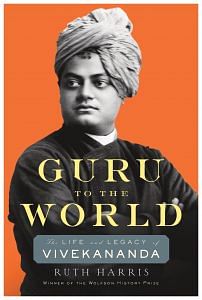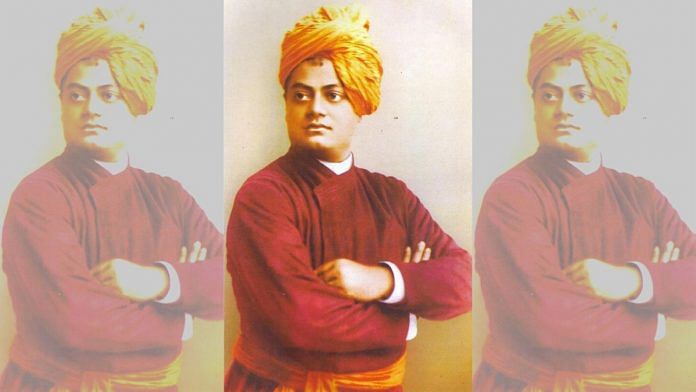Vivekananda’s parents wanted Vivekananda to have the most advanced education possible. They therefore enrolled him at the Metropolitan Institution in 1871, recently founded by Ishwar Chandra Vidyasagar as one of the first private and secular schools in India staffed by Indians. Vidyasagar has been called India’s Erasmus, a title that tries to express to Westerners his broad learning and significance. But despite these promising beginnings, Vivekananda’s early education was disrupted. After a two-year hiatus that lasted until 1880 when he lived with his family in Raipur, he went for a short time to Presidency, the city’s premier school, then moved a year later to the General Assembly Institution (now known as the Scottish Church College), the oldest liberal arts and sciences college in India.
This connection underscores the significance of Christianity in Vivekananda’s development. Founded in 1830 by Alexander Duff, the first Church of Scotland missionary in India, the school offered English instruction, including lessons from the Bible. Duff was a major figure in the endless debates concerning “native” education.
Even though Western orientalists sang the praises of Indian poets and dramatists (particularly the classical poet Kalidasa, one of Vivekananda’s favorites) the British proscribed such works as too “exotic,” “romantic,” and “erotic” for Indian youth. In contrast to the secular curriculum prescribed in the government institutions, Duff’s church school emphasized Christian scripture; there, both Duff and his successor, the Reverend William Hastie (Vivekananda’s teacher), prioritized English romantic poetry; they believed such readings would enlarge the virtuous and sentimental imaginings of young Indians and ready them for an appreciation of the Bible.
Also read: Gyanvapi in Varanasi to mosque in Mathura—IAS officer’s first-hand account post-Babri riots
In touching the heart and not the head, such verse was crucial. But along with these lessons, Vivekananda’s move to the General Assembly Institution meant that he was also confronted by the full force of Calvinist ideas of sin, duty, and hellfire, an early training that may explain his later distaste for certain aspects of Protestant theology. He was thus formed in institutions that underscored these young men’s status, but that also asserted Christian and British culture over Indian traditions.
Vivekananda became culturally ambidextrous, gaining a facility with the English language that would impress Westerners with his fluency, literary reference, and endless wordplay. His experience also turned him into an unwilling expert in comparative religion: when he went to the West, he knew the Gospels as well as did many a Christian. This knowledge certainly empowered him in debate and dazzled his audiences; and yet, we can only imagine how the mounting pressure of this internal dialogue may have contributed at moments to resentment. His grasp of English literature contributed to his aura of intellectual refinement among his Western acolytes, but also underscored the power of British cultural hegemony. Of equal significance, however, was Brahmoism, a reform movement that shaped some of the greatest figures in the Bengali elite, and which had generated its own variation of “Hindu Universalism.”
By the time he met Ramakrishna in 1881, Vivekananda was the outspoken product of three generations of Brahmo ideas and spiritual questioning. However, its early founders had so stripped Brahmoism of much Hindu thought and practice that opponents did not regard it as Hinduism at all. Certainly, Brahmoism abandoned caste, but it also dispensed with the images and Puranic talesthat were integral to popular worship, and therefore retained an intellectual and exclusive aura. Roy’s vision of Hindu Universalism was one of “subtraction,” a means of disposing of what was “false” and “superfluous”; hence his Religious Universalism (1829) drew mainly on Hindu examples.
Also read: What is Pachisi? Ancient Indian board game Mughal emperor Akbar enjoyed
By becoming a Brahmo, Vivekananda rejected polytheism, image worship, divine incarnation, and the guru cults of contemporary Indian spirituality. Indeed, because of his apparent skepticism, he seemed destined to enter and then stay in its ranks. Brahmoism would not have precluded Vivekananda from becoming much like his father, a householder and maybe a legal advocate, but perhaps with greater intellectual and political drive. For our purposes, this movement’s significance lies in the way Vivekananda came to Ramakrishna as a young man deeply marked by its teachings and outlook. Like other Calcutta youths, he was indebted to the “father of modern India,” Raja Ram Mohun Roy; Roy remained a hero for him, and when Vivekananda taught his American disciples in the summer of 1895, he lauded the “great Hindu reformer” for his “unselfish work,” and devotion to India.53
The founder of the Brahma Sabha [Assembly of God], Roy had condemned both Hindu polytheism and Christian Trinitarianism in the early part of the nineteenth century and argued for a “purification” of the subcontinent’s traditions.54 His great erudition (Roy knew Arabic, Persian, Sanskrit, Bengali, and English) enabled him to engage with Muslim mono-theism, while also poking fun at the conceits of both Hinduism and Islam.
He unusually joined critical theology to the managing of religious difference through ethical reasoning, and later learned Hebrew to combat Christian missionaries.55 In his Bengali writings, he emphasized a single all-pervading Lord from the Upanishads, the ancient Sanskrit texts.56 While this view of God also existed in the Tantras and the Puranas—the large body of Hindu myth and legend—Roy rejected these as corrupted accretions, and focused instead on the last and, in his view, highest stage of Vedic antiquity in a hoped for return to origins. He also repudiated avataras (incarnations of a deity), integral to the stories of Hindu gods (and Ramakrishna’s life).
 This excerpt from Ruth Harris’s ‘Guru to the World: The Life & Legacy of Vivekananda’ has been published with permission from Harpers Collin India.
This excerpt from Ruth Harris’s ‘Guru to the World: The Life & Legacy of Vivekananda’ has been published with permission from Harpers Collin India.



